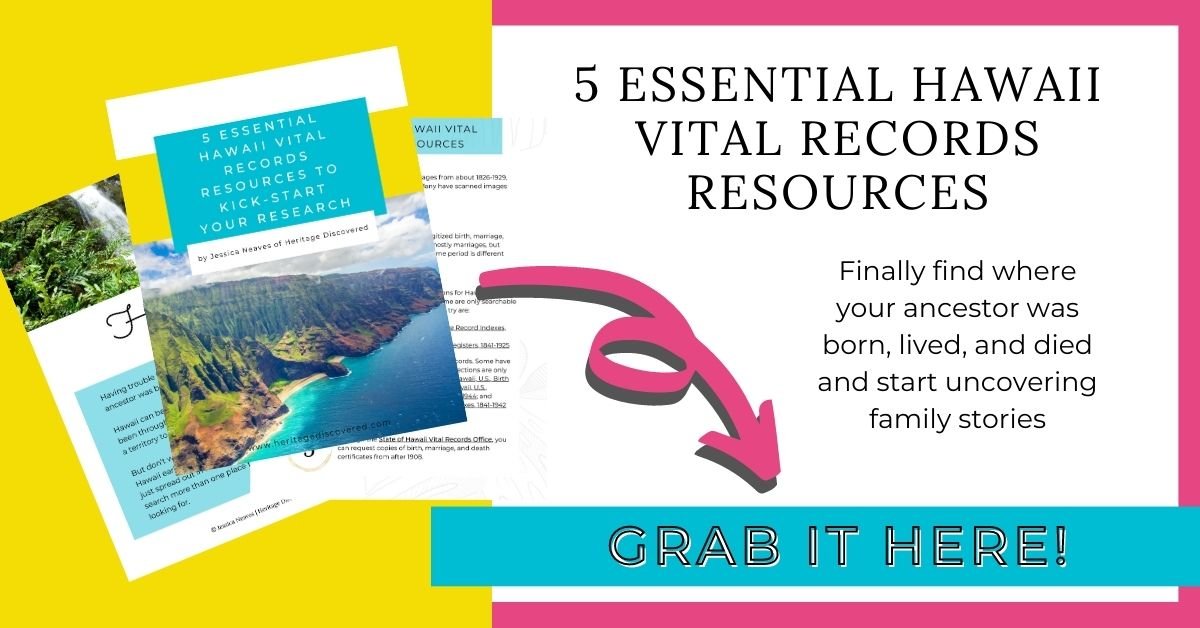5 Fantastic Resources To Trace Your Ancestors That Immigrated To Hawaii
*This post may have affiliate links, which means I may receive commissions if you choose to purchase through links I provide (at no extra cost to you). All opinions remain my own.
Which branches of your family tree emigrated to Hawaii?
My maternal great-grandparents came to Oahu from Okinawa in 1905 and 1911. When I started my family tree research, I knew their names but not when they arrived or where they were all from.
I also didn’t know anything about the names of their parents or siblings. Did they even have siblings? Did any other family members also come to the US?
After a lot of digging, I found resources to help uncover more about their immigration story.
If you have ancestors who immigrated to Hawaii, but you don’t know where they were born, when they landed, or are simply looking for more resources for your family history research, you’re in the right place.
In this article, I’m sharing five resources to support your genealogy research on immigrants to Hawaii.
Related posts:
10 Terrific Resources For Identifying Your Immigrant Ancestor’s Hometown
How To Save Hours Of Time With These 8 Translation Tools For Genealogy
What Are Naturalization Records And How Can They Support Your Research?
A brief history of immigration to Hawaii
First, let’s start with a quick, general timeline of when different ethnic groups began to migrate to the islands.
About 1835, the first sugar cane plantation started on Kauai with Hawaiian workers. In January 1852, the first Chinese field workers arrived, launching Chinese immigration to Hawaii.
In 1868, the first mass emigration of Japanese migrant laborers – 153 of them – set out to work the sugar plantations. A decade later, Portuguese workers began to migrate there. Twenty years later, a law barred additional Chinese laborers from coming to the islands, an exclusion that lasted decades.
After the Kingdom was annexed in 1898, the first laborers from Okinawa began to come over two years later. Koreans and Puerto Ricans followed shortly after. Late in 1906, the first 15 Filipino plantation workers reached Honolulu.
By the first US federal census of Hawaii in 1900, there were over 25,000 Chinese and over 61,000 Japanese living on the islands.
In 1910, Hawaii had about 191,000 people total and various cultures made up a large percentage of that, with about:
22,000 Portuguese
5,000 Puerto Ricans
80,000 Japanese
21,000 Chinese
4,500 Koreans
By 1920, the population had grown to over 255,000, about one-third of which was born in another country. The number of Japanese saw one of the biggest increases, with almost 110,000 people. Most other groups like Portuguese, Chinese, and Koreans saw only small growth. Filipinos had also begun to migrate in large numbers by this time, with over 21,000 throughout the territory.
Related posts:
Why Should You Use Ethnic Newspapers For Genealogy Research?
How To Add More Details To Your Family Tree With Passport Applications
5 genealogy resources for immigrants to Hawaii
Here are five resources on Hawaii immigration records to help with your family history research. I’ve included a couple of general resources related to immigration to Hawaii, as well as some ethnic-specific sources.
If you don’t know when your family came to Hawaii or if they became citizens, use tools like a US census immigration worksheet to pull together all their immigration clues in one place. You can then use those clues to help you use the following resources, as well as other immigration-related genealogy records.
1) Honolulu, Hawaii Passenger Lists
Ancestry has a great collection titled “Honolulu, Hawaii, U.S., Arriving and Departing Passenger and Crew Lists, 1900-1959”. These passenger lists include Chinese, Puerto Rican, Okinawan, Japanese, Filipino, and other immigrants to Hawaii.
FindMyPast has a similar collection.
You can find the basics about each passenger, like their name, age, gender, occupation, and marital status. But even more important, the manifests include their last permanent residence, birthplace, and who they were going to join, The lists also say when and where they last arrived in the US and give a physical description.
The manifests can be hard to read but if you’re persistent you can glean a lot of valuable information.
Here is a snippet of part of a page from 1913. The columns show the address of a contact in their home country, their destination, whether they had been in the US before, and who they were going to meet.
2) The Hawaii Sugar Planter’s Association records
Brigham Young University has a wonderful collection on Filipino immigration to Hawaii. The Hawaii Sugar Planter’s Association records include labor records and passenger lists for about 100,000 Filipino plantation workers in Hawaii.
The collection has information on contract workers, including their name, age, gender, dates of arrival and/or departure, and which plantations they worked at.
But what’s even better is that they can share the native town of the worker, marital status, and the names of spouses and children. The records may also show how much they made and how much they sent home to the Philippines. I’ve also seen notes like death dates and causes.
Some even have fingerprints! While you can’t really use the fingerprints for other research, it is a very unique thing not found on many other genealogy documents.
3) Index to Portuguese Passenger Manifests
The Hawaii State Archives has an Index to Portuguese Passenger Manifests collection for Portuguese immigration to Hawaii from 1843 to 1900.
While basic, these index cards can have a lot of genealogical information in them. Not only do they state the name of the immigrant and their age, but also the names and ages of family members traveling with them.
They also give the port of embarkation, giving you a clue about where your Portuguese ancestors may have come from. You can also find the date of arrival or departure from Hawaii and the ship’s name.
4) Okinawan Emigrants Database
Next is a resource that I have used many times in my personal research on Okinawan immigration to Hawaii, the Okinawan Emigrants Database.
Created by the Okinawan Genealogical Society of Hawaii, this is a wonderful database for uncovering where your ancestor was from, when they immigrated to Hawaii, and more. Depending on how common your ancestor’s name is, it helps to know their birth date or at least an estimated birth year.
You can find other relatives, their destination city, name in kanji, the purpose of their trip, age, birth date, and passport number and date.
What’s even more special is you can find their exact address in Okinawa.
This database helped me learn where all my Okinawan ancestors were from, as well as the names of my great-grandfathers’ older brothers.
5) Alien registration files
Alien registration files are another type of immigration-related record for people of all ethnicities that went to Hawaii.
I’ve written about “A-Files” before, but in short, A-Files began in the 1940s and all immigrants who weren’t citizens had to register with the government.
Millions registered. We’re talking over 60 million. So there is a good chance that you might find at least one for your family members.
You can find lots of genealogical tidbits about your ancestor in them, including where they were from, their birth date and place of birth, death reports, naturalization papers, and what name they entered the US under. I’ve also found photos, including the only picture I have of one of my great-grandmothers.
Because of the restrictive laws at the time on Asian citizenship, if you have Asian heritage, you are likely to find your ancestor had a file.
Related posts:
11 Smart Strategies For Searching For Ancestors Who Changed Their Name
Why Isn’t My Ancestor in the Census?
How To Use Online Family Trees The Right Way
6 Common Genealogy Mistakes And How To Avoid Them
Final thoughts
Genealogy resources like alien registration files, ship manifests, and employment records are great places to discover details about your ancestors that immigrated to Hawaii.
Through them, you can uncover hometowns, names of relatives, their birth dates, the date and ship they arrived on, and more.
Tools like a census immigration worksheet are handy for gathering facts to help you use along with the resources in this article, as well as others.
Which resources have you already used to research your ancestors in Hawaii?



